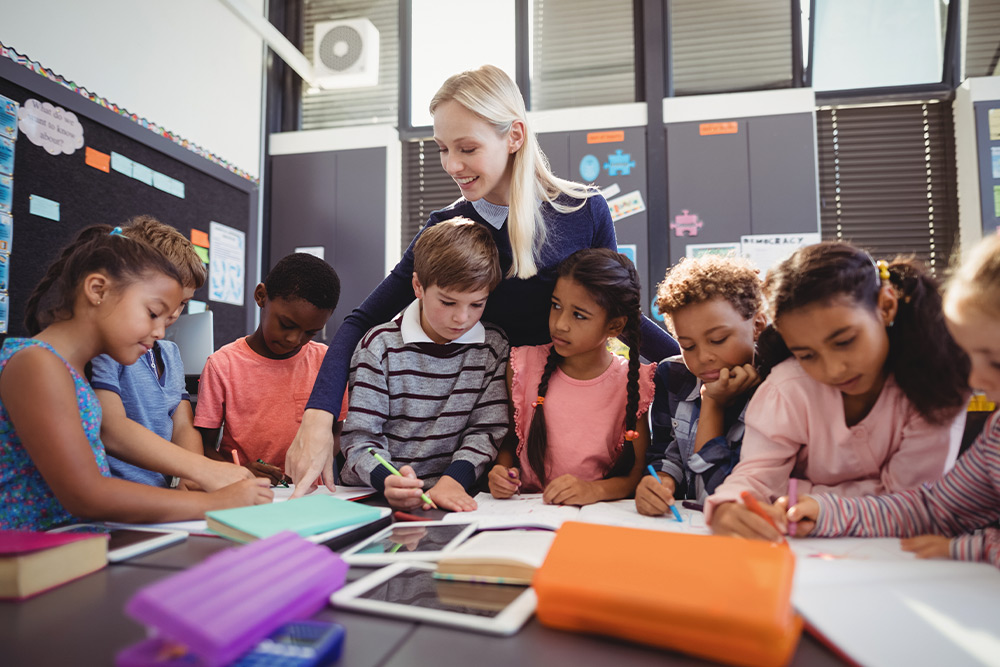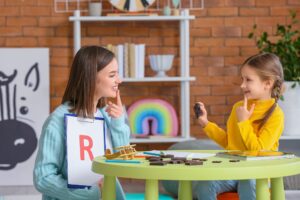
How Science Experiments Help SLPS Get Students Talking!
Want to engage your speech therapy students at a whole new level? Slide some science experiments into your session plan!
When Speech Language Pathologists (SLPs) use experiments, they can make students feel more motivated, elicit more language from them, and help them hone in on several key language skills.
Not to mention–incorporating science into speech therapy is an awful lot of fun!
At Pediatric Therapeutic Services (PTS), we love sharing easy activities our clinicians can use to help students progress toward their goals. We’ve already shared a bunch of SLP group therapy activities we like. Now, we want to show you some simple experiments you can do with your students.
Seven Speech Therapy Goals Science Experiments Help Kids Reach
Consider how many speech and language goals even the simplest science experiments can help your students achieve:
1. Articulating
You can’t expect kids to pronounce “photosynthesis” correctly every time. However, talking through experiments offers the chance to practice and master new words, including specialized science vocab, and strengthen connected discourse ability.
2. Following Directions
Following directions for making PB&Js is one thing. Following them to stay safe while causing cool chemical reactions or building basic electronic circuits is something else! Kids often find step-by-step science instructions more interesting and exciting than mundane ones, and they’re still getting valuable practice in a critical everyday skill.
3. Reading
Instead of reading the instructions to your students, have kids read them to you. Ask them to read aloud passages in age-appropriate science books explaining the experiments’ concepts. It’s good practice in improving word recognition, comprehension, and reading speed.
4. Sequencing
Science experiments are ready-made opportunities to practice sequencing. Encourage students to tell you, step by step, what’s going to happen in an experiment (in the correct order) or review what happened after the fact.
5. Describing
Tired of targeting expressive language by always having kids describe scenes from a picture book? Recording and relaying observations is integral to scientific work. Set up experiments in which students describe colors, sounds, smells, and more.
6. Predicting and Inferencing
Making educated guesses about what will happen in a text passage and drawing conclusions about why are essential reading comprehension skills many kids with language delays find challenging. Making and testing hypotheses give students another way to develop these abilities.
7. Socializing
Cartoons and movies frequently show “mad scientists” alone in the lab, but real science is inherently collaborative and social. Whether you want students to practice taking turns, following multi-step directions, or observing others’ personal space, gathering around the table for a group science project can help.
Five Favorite Experiments SLPs Can Use to Get Kids Talking
You don’t need high-tech gadgets or a spic-and-span lab to do experiments. SLPs can find tons of science experiments that only need cheap supplies commonly found in schools and homes.
Here are five options to get you started:
1. Oobleck
Named after the sticky green stuff in Dr. Seuss’ Bartholomew and the Oobleck, oobleck is a mixture of cornstarch, water, and food coloring that behaves as a solid and a liquid. Scientists call it a non-Newtonian fluid. Kids call it “creamy,” “soft,” and “weird.” We call it a wonderful way to elicit language!
2. Slime
Stir together borax solution, glue solution, and food coloring (kids’ science experiments involve lots of food coloring) for goopy, gloppy, glorious slime! How many adjectives will kids come up with to describe this mysterious stuff?
3. Dancing Raisins
We heard it through the grapevine: If you drop raisins in a glass of clear carbonated soda, they’ll boogie their way right up to the top. Use this experiment to get kids talking about density, volume displacement, and carbon dioxide.
4. Elephant Toothpaste
Safety goggles, an empty plastic bottle, dry yeast, warm water, liquid dish soap, hydrogen peroxide, and food coloring (we weren’t kidding) are all you need for this kid-pleasing chemical reaction.
5. DIY Tornado
No need to seek shelter from this twister. Pour water, liquid dish soap, and vinegar into a mason jar, screw the lid on tightly, swirl the jar, and enjoy the show! You can also add glitter. (You thought we’d say food coloring, right?)
Simple experiments make especially appealing options when you’re delivering services via teletherapy.
Simply ask students and their families to round up the necessary supplies, make sure you and your students are clearly visible to each other over the webcam, and enjoy hearing kids talk about their scientific “breakthroughs!”
Whether your sessions are virtual or in-person, ask plenty of specific “wh-” questions— “What did you do first?,” “Why did you…?,” “When did you…?,” “What happened?”—to maximize these experiments’ speech therapy value.
PTS Can Help You Succeed as a Speech Language Pathologist (SLP)
Even if you don’t consider yourself “science-y,” you’ll love the power of science experiments to spark new enthusiasm for speech therapy in your students and accelerate their achievements.
From easy-to-use strategies like the above experiments for SLPs, to our efforts in helping therapists serve kids in trauma-sensitive ways, which you can read more about when you download our free eBook, Trauma-Informed Care: Key Principles and Best Practices for Therapists, creating innovative ways to deliver related services is fundamental to our work at PTS.
Be sure to check out how all our resources can help you succeed as a speech language pathologist, as well as our currently available positions.
REMEMBER: Some scientific fun can go a long way when targeting your students’ goals!



